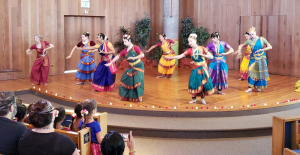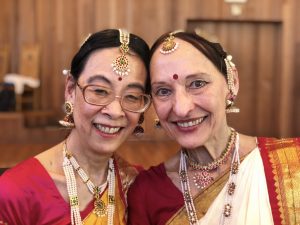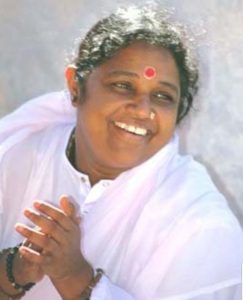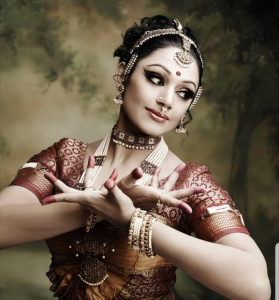
Church and Sunday sermons go together, but this event at the charming St. John’s Episcopal church in Berkeley took a leaf out of a different Bible, the Natya Shastra, the ancient treatise for India’s classical performing arts. The stage was given over to a performance of the classical dance of Bharatanatyam, by students of Aggie Brenneman’s school, the Bala Center for South Indian Dance. Church might not be the first place you would associate with a Bharatanatyam recital, but this was free spirited Berkeley, where several world traditions overlap in vibrant harmony, and one can choose to be joint citizen of as many as appeal to the soul.
The occasion was to celebrate the legacy of Tanjore Balasaraswati, or Bala, India’s legendary doyenne of the Tanjore school of Bharatanatyam. This year marks Bala’s birth centenary, which is being commemorated by aficionados of dance and music around the world. In her landmark tour of the United States in the early sixties, the New York Times fittingly christened Bala as the ‘First Lady of Bharatanatyam’ who ‘spoke through dance’. This supreme artiste went on to teach and train several dedicated American students, who took to the world of this classical art form with an enduring commitment and sincerity. Today, many of them are divas in their own right, continuing to carry Bala’s legacy forward. And here was one of Bala’s finest students, Aggie, offering tribute.
The crowd for this Sunday afternoon was a lively and cheery lot. It comprised all ages, from infants and toddlers to parents and elder folk, making for a family outing as much as a recital of dance. Among them of course were serious students and enthusiasts of dance, all ready and eager for the program to commence.
The opening featured the traditional invocatory piece, the alarippu, (flowering bud), in the rhythmic 3 pulse gait of tisram, performed by eight senior students of Aggie. They set the tempo well, their coordinated rhythms showing even in this brief piece that they were dancers of promise.
The next, also invocatory piece was the Natesha Kavutvum, in praise of Nataraja, the Lord of Dance. Two of Aggie’s students held the audience’s interest with their pacing and beautiful poses of the Ananda Tandava, the cosmic dance of creation.
Cute little ankle bells jingled on cuter little feet for the next piece of the show, as six of the youngest students of the school, none a day older than six, stepped gingerly on stage. This had to be their first time in front of a group of any size, and they had to both introduce themselves and tell a couple of lines of the story of Krishna they were going to enact. Their first piece was a sequence of basic adavus, or rhythmic steps, set to the music of a popular devotional song, the Thullu Matha in praise of the Lord Muruga. Even as they danced their petite little steps, the manner in which they stole quick glances at each other to ensure they were all synchronized was most amusingly charming.
Next, they enacted the famous episode of the child Lord Krishna perched atop a human pyramid of his naughty companions, aiming for the forbidden butter in a pot hung high and out of reach. As the plans unravel, Krishna the butter thief is caught and reprimanded. Entertaining as only children can be, the reprimand these kids dealt the child Lord lighted up everyone in smiles. As the row of little anklets trooped off stage, they received roaring applause.
A set of seven kids from the after-school program came on stage now, first for a devotional invocation piece, followed by the recounting and enactment of another episode from the life of Krishna. The episode this time was Krishna the teenager’s teasing of the blue-eyed maidens by making off with their clothes even as they bathed in the river. The unspeakable naughtiness of the prank, with the vociferous protest of the maidens and the air of indifference from the flute playing teenager, were all portrayed most delightfully.
Kids, indeed, played their cute part from the audience as well. One positioned himself in the center of the aisle, providing comic relief by keeping time and beat with the goings on. Another kept time jumping, while a third attempted an inverted pose in trying to mimic the poses on stage. Little girls skipped around in paavadais, their hair braided with flowers. This could well have been a concert in an Indian sabha.
The next piece, by a group of five older kids, showcased a slightly more involved dance sequence for the devotional song, Ra Ra Rama. The coordination that comes easier to older children was much in evidence here. They then proceeded to dance the Ganapati Kavutvum, in praise of the elephant headed deity Ganesha, involving a faster tempo of steps. The hand mudras (gestures) depicting Ganesha’s trunk that made short work of obstacles, his playing of cymbals, and his large flapping ears, were particularly endearing.
The next piece had an unusual cast of two mother-daughter pairs on stage. They first performed a different version of the Ganapati Kavutvum, and then went on to a slightly more elaborate piece, the Jatiswaram. The dances were now more intricate, and the performance climbed steadily to match. Other older students then performed the Vallacci, a dance story encapsulating the search for the divine in the search for human love. The more nuanced head movements came into play now, keeping step gracefully with a decidedly more energetic tempo, and evincing meritorious talent.

The piece that followed was a surprise treat, and a lovely one, not originally announced in the schedule. Aggie now came on to stage herself, to enact an episode from the story of the medieval saint Nandanar, where the view of his favorite deity Lord Shiva from outside the sanctum is obscured by the large statue of a bull.
Aggie’s performance shone with an exemplary classicism. All graceful flow, she portrayed the human element of the story with a surpassing emotion, bringing vivid glimpses of her legendary teacher. The high vocals that accompanied this piece were a recording of renowned vocalist T. Muktha, complementing the dance perfectly. We were witness to a remarkable tribute in spirit.
Six of the most accomplished of Aggie’s students brought up the final performance of the evening. They included, among others, the evergreen Evelyn Leong, upcoming teacher Deepa Natarajan and promising debutante Ruby Spies. The skillful portrayal of the Sakhiye varnam, where a love stricken woman confides in her friend, entreating her to trace and bring her back her beloved, visibly moved hearts. The piece was replete with abhinaya, the evocative communication of sentiment that marks depth of maturity in classical Indian dance. These were certainly students in the pursuit of excellence.
It is over thirty years now that the legendary T. Balasaraswati has passed on. The legacy she has left, however, is one of a living passion for dance. Aggie’s students range from the under seven to the over seventy. The audience could clearly sense the spark in them, as they went back all on stage for a final bow, evoking grand applause. And Bala, taking in the scene from wherever she might be on the celestial stage, would have surely leapt for joy.



